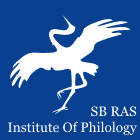 |
|
||||||||||||
|
Institute of Philology of
the Siberian Branch of Russian Academy of Sciences |
|
||||||||||||
|
|||||||||||||
| Sibirskii Filologicheskii Zhurnal (Siberian Journal of Philology) | |
|
Article
Authors: K. I. Dekatova Volgograd State Socio-Pedagogical University, Volgograd, Russian Federation In the section Linguistics
Abstract: This paper is devoted to the description of the meaning-making process of linguistic units in a literary text. The results of the study are shown, indicating the synergy of cognitive and semantic structures in discursive literary space. The cognitive-semiological approach used in this study allows analyzing the processes of semantic structuring of a language sign taking into account the peculiarities of its semantic modifications, the specifics of the content of the conceptual structure verbalized by the sign, as well as the influence of context on cognitive and semiological processes in the course of the formation of the sign content in a literary text. When applying the approach concerned, the author studies the meaning-making of the idiom “druzhba narodov” (“fraternity of peoples”) that is used repeatedly in “Chernil’nyy angel” (“Ink angel”) by V. G. Popov. The semantic structure of this idiom is formed in different contexts under the influence of various cognitive factors, such as the content of the Soviet concept of “Druzhba Narodov” (“Fraternity of peoples”), knowledge about the manifestations of friendly relations between representatives of different nationalities in everyday life. This knowledge becomes a source of basic semes of phraseological meaning. However, the semantic core of sememes changes in the different parts of the literary text, influenced by a macro-context (discourse) and a micro-context (linguistic distribution of an idiom). Sometimes, in “Chernil’nyy angel,” the idiom concerned acquires sememes, the core (the explicit part) of which is formed from semantic elements of discursive origin. In addition, the use of the analyzed idiom in a variety of distributions leads to different elements being explicit in its semantic organization. Studying the combination and organization of these elements in the process of using the linguistic unit in the space of literary text can contribute to understanding the mechanisms of interaction between the linguistic and conceptual systems in the discursive space. Keywords: meaning-making, literary text, semiological analysis, concept, discourse Bibliography: Alefirenko N. F. Kognitivno-semiologicheskaya teoriya slova [The cognitive-semiological theory of the word]. Vestnik of Samar State University. 2006a, no. 5/1 (45), pp. 102–110. Alefirenko N. F. Yazyk, poznanie, kul’tura: kognitivno-semiologicheskaya sinergetika slova [Language, cognition, culture: cognitive-semiological synergetics of a word]. Volgograd, 2006b, 228 p. Babenko N. G. Okkazional’noe v khudozhestvennom tekste: Strukturno-semanticheskiy analiz [Occasional in a literary text: Structural-semantic analysis]. Kaliningrad, Kaliningrad univ., 1997, 83 p. Babenko L. G., Kazarin Yu. V. Lingvisticheskiy analiz khudozhestvennogo teksta [Linguistic analysis of literary text]. Moscow, Flinta, 2009, 495 p. Barthes R. Izbrannye raboty. Semiotika. Poetika [Selected texts. Semiotics. Poetics]. Moscow, Progress, 1989, 616 p. Belova N. A. Filologicheskiy analiz khudozhestvennogo teksta: realizatsiya integratsii lingvisticheskogo i literaturovedcheskogo podkhodov v shkole [Philological analysis of literary text: implementation of integration of linguistic and literary approaches in school]. Saransk, MRSU Publ., 2008, 205 p. Bolotnova N. S. Filologicheskiy analiz teksta [Philological analysis of text]. Moscow, Flinta, Nauka, 2009, 520 p. Chernyakhovskaya L. A. Smyslovaya struktura teksta i ee edinitsy [Semantic structure of the text and its units]. Voprosy Jazykoznanija (Topics in the study of language). 1983, no. 6, pp. 117–126. Fateeva N. A. Kontrapunkt intertekstual’nosti, ili Intertekst v mire tekstov [Counterpoint of intertextuality, or Intertext in the world of texts]. Moscow, Agar, 2000, 280 p. Filosofskiy entsiklopedicheskiy slovar [Philosophical encyclopedic dictionary]. L. F. Il’ichev, P. N. Fedoseev, S. M. Kovalev, V. G. Panov (Eds). Moscow, Sov. entsikl., 1983, 840 p. Gak V. G. K probleme semanticheskoy sintagmatiki [To the problem of semantic syntagmatic]. In: Problemy strukturnoy lingvistiki [Problems of structural linguistics]. 1971, Moscow, Nauka, 1972a, pp. 366–395. Gak V. G. Povtornaya nominatsiya i ee stilisticheskoe ispol'zovanie [Secondary nomination and its stylistic use]. In: Voprosy frantsuzskoy filologii [Topics in the study of French Philology]. Moscow, MGPI im. Lenina, 1972b, 218 p. Greimas A. Strukturnaya semantika: poisk metoda [Structural semantics: searching for a method]. Moscow, Akadem. proekt, 2004, 368 p. Dekatova K. I. Smysloobrazovanie znakov kosvenno-proizvodnoy nominatsii: kognitivno-semiologicheskiy aspekt issledovaniya [The sense structuring of indirect-derivative nomination marks: cognitive-semiological aspect of research] Volgograd, Peremena, 2009, 260 p. Kolchina O. N. Semasiologicheskiy i onomasiologicheskiy podkhody k izucheniyu yazykovoy lichnosti [Semasiological and onomasiological approaches to the study of linguistic personality]. Vestnik of Lobachevsky University of Nizhni Novgorod. 2010, no. 3, pp. 332–335. Kuzmina N. A. Intertekst i ego rol’ v protsessah ehvolyutsii poeticheskogo teksta [Intertext and its role in the evolution of the poetic text]. Ekaterinburg, UrFU Publ., Omsk, OmSU Publ., 1999, 268 p. Larin B. A. Estetika slova i yazyk pisatelya [The aesthetics of words and language of the writer]. Leningrad, Khudozh. lit.,1974, 283 p. Lotman Y. M. Struktura khudozhestvennogo teksta [The structure of the artistic text] In: Ob iskusstve [About the art]. St. Petersburg, Iskusstvo, 1998, pp. 14–285. Nikitin M. V. Leksicheskoe znachenie (struktura i kombinatorika) [Lexical meaning (structure and combinatorics)]. Moscow, Vyssh. shk., 1983, 127 p. Novikov A. I. Semantika teksta i ee formalizatsiya [The text semantics and its formalization]. Moscow, Nauka, 1983, 215 p. Palmer D. Porody sobak [Breed of dogs]. Moscow, Eksmo-Press, 1999, 80 p. Panchenko N. V., Kachesova I. J., Komissarova L. M., Chuvakin A. A., Zemskaya J. N. Teoriya teksta [The theory of a text]. Moscow, Flinta, Nauka, 2010, 132 p. Saussure F. Kurs obshchey lingvistiki [The course of general linguistics]. Moscow, Editorial URSS, 2004, 256 p. Shanskiy N. M. Lingvisticheskiy analiz stikhotvornogo teksta [Linguistic analysis of the poet- ic text]. Moscow, Prosveshchenie, 2002, 224 p. Stepanov Y. S., Edel’man D.I. Semiologicheskiy printsip opisaniya yazyka [Semiological principle of the description of language]. In: Printsipy opisaniya yazykov mira [The Principles of description of languages of the world]. V. N. Yartseva, B. A. Serebrennikov (Eds in ch.). Mos- cow, Nauka, 1976. pp. 203–281. Turaeva Z. Ya. Lingvistika teksta: (Tekst: struktura i semantika) [Text linguistic (Text: struc ture and semantics)]. Moscow, Prosveshchenie, 1986, 127 p. Ufimtseva A. A. Leksicheskoe znachenie (printsip semiologicheskogo opisaniya leksiki) [Lexical meaning (principle of semiological description of lexicon)]. Moscow, Nauka, 1986, 240 p. Vinogradov V. V. Izbrannye trudy. O yazyke khudozhestvennoy prozy [Selected works. About the language of fiction]. Moscow, Nauka, 1980, 360 p. Vysotskiy V., Vysotskaya V. Dressirovka otechestvennykh volkodavov [Training of domestic wolfhounds]. Moscow, Akvarium-Print, 2004, 192 p. |
 |
Institute of Philology Nikolaeva st., 8, Novosibirsk, 630090, Russian Federation +7-383-330-15-18, ifl@philology.nsc.ru |
© Institute of Philology |


